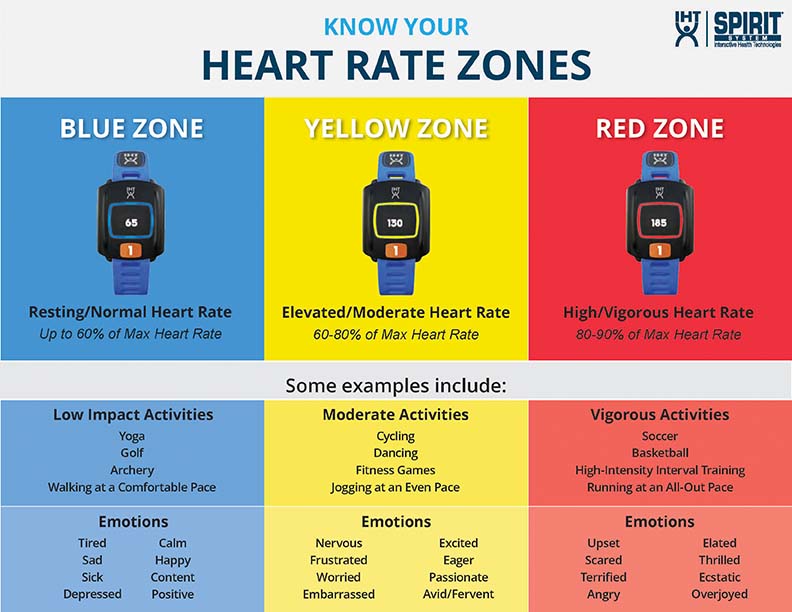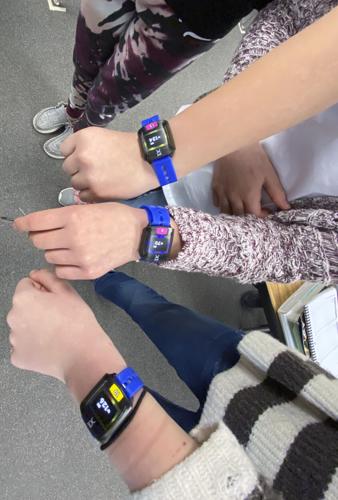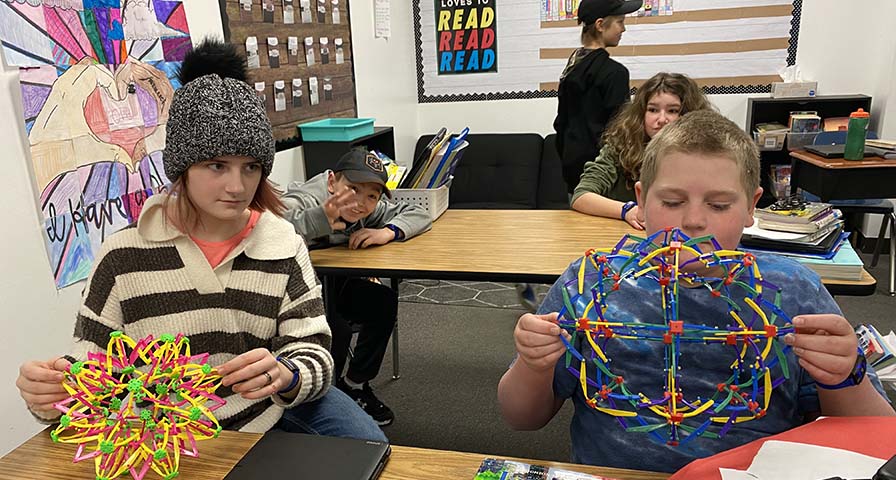A Braham Elementary student uses a Hoberman sphere while wearing a heart rate monitor to see how breathing impacts heart rate.
Heart Rate Monitors Enable Students to Visualize Emotions and Utilize Breathing Techniques to Stay Calm, in Control During School Days
Elementary school social worker Jonelle Klemz credits a heart rate monitor – the IHT ZONE – with allowing her to help more students than ever before learn to manage their emotions.
“This is a pretty amazing tool,” Klemz, the social worker at Braham (Minn.) Area Schools, said. “I’ve wanted to be able to see every student in the school for 23 years and I didn’t know how to do that. Well, now I’m doing that.”
By the end of the school year, Klemz will have worked with every student at Braham Area Elementary School, either directly in her office or by spending a week in every classroom teaching students about the relationship between heart rate, emotion, and physical activity.
“My referrals are up like crazy,” she said. “I think all kids need this information. In a time where it’s been extra busy and there has been a lot of need, I feel totally renewed in my job.”
During her week in a classroom, Klemz starts the day with a 15-minute lesson about breathing and managing emotions and has students – and the teacher – put on the IHT ZONE heart rate monitors. The monitors – Bomber Bands to the students (after the school’s mascot) — enable students and teacher to see when their heart rate becomes elevated, prompting them to use the breathing techniques Klemz teaches as calming strategies.
“Every day I teach them a way to remember how to breathe and then I do a lesson where feelings come from, why we have feelings and I try to focus on anger and frustration because those are big feelings, difficult to manage,” she said. “We get into how our thoughts cause feelings and if we can tone down or change our thoughts, we’ll feel better.”
Students use Hoberman Spheres, known as breathing balls, that they can expand and contract as they work on breathing in and out. She also teaches techniques that include Navy Seals Box Breathing – breathe in and hold it for 4 seconds, then breathe out and hold it for 4 seconds.
“We talk about how our body feels,” she said. “The third graders don’t always know if they are hyper because they’re excited or because they are anxious. This gives you a chance to learn that about yourself. So I tell them they are scientists this week and you’re studying yourself. You get to see how different things feel.”
Understanding What ‘Stress Looks Like’
 Klemz said students are typically quick to figure out why their heart rate rises and falls at certain times. For some, it can be eye-opening. Students review their heart rate report – how many minutes they spent in each heart rate zone (designated by color on the graph and on the heart rate monitor itself) along with a graph of their day – with Klemz before going home.
Klemz said students are typically quick to figure out why their heart rate rises and falls at certain times. For some, it can be eye-opening. Students review their heart rate report – how many minutes they spent in each heart rate zone (designated by color on the graph and on the heart rate monitor itself) along with a graph of their day – with Klemz before going home.
- Blue signifies normal levels of activity or emotions such as calmness
- Yellow signifies moderate heart rate activity or emotions such as excitement, mild stress, or frustration
- Red indicates vigorous heart rate activity or emotions such as elation, anger, or extreme stress.
Together, Klemz and each student do a quick reflection on what the graph shows.
“I like to just let them ponder it,” Klemz said. “One girl, I think she was either fifth or sixth grade, was spiked up out of nowhere into the high yellow, low red. I just kind of looked (at the graph) and wondered what that was.”
The student quickly remembered why her heart rate appeared elevated.
“And she says, ‘oh, I know, that was a hard test and I wanted to do well,’” Klemz said. “Then she turns to me and asks, ‘so, is that what stress looks like?’
“It was awesome,” Klemz said. “I asked if she did the breathing and she said she did. She also said it helped that the test was over.”
A similar conversation, Klemz said, plays out with each student. They see the graph, notice when their heart rate went up, and explain why. One student’s heart rate report showed him elevated into the red zone for more than an hour – during PE class.
“That wasn’t unexpected,” Klemz said, but the reason for the elevation wasn’t what she expected.
“I asked what he was doing, and he didn’t answer and put his head down,” Klemz recalled. “I finally asked if he remembered and he said, ‘I remember, I was mad the whole time.’ Kids were cheating at the game they were playing, and he got mad, and he couldn’t calm down.’”
But, thanks to the morning breathing and stress management lessons, he regrouped and eventually brought his heart rate back down, letting go of the anger.
“That’s a student who would have been upset the whole day,” Klemz said. “We looked at his chart and he was blue the rest of the day. So I just told him how proud I was of him that he didn’t let that wreck his day. Typically, he would have been off all day. He said he did the breathing and it made him feel better.”
When Klemz noticed that an entire class had a spike in heart rate when they weren’t in PE, she turned to the teacher and asked if he had given a test at that time. No, she learned, just an active brain break.
“With a little prompting, I learned he had them get up from their desks and do some jumping jacks and get really active,” she said. “I think the teachers are learning to use that as a tool to help generate good learning for the rest of the day. When you work your heart out really hard during the day, it’s going to help you manage those feelings and manage the hard work we have to do.”
Klemz reviews the data every day with each student. Twice during the week she prints out the graph to share with parents so they can see the progress their students are making.
“Sometimes parents think their kids need to work with me,” Klemz said. “By doing this in the classroom, I’m hitting some of the kids whose parents initially thought they needed to see me regularly. I think they learn enough in five days to manage their feelings. Sometimes it’s just about school. School is hard.”
Building an Emotional Health Program from the Ground Up
Klemz began wearing her own heart rate monitor through a district-wide initiative and saw how her emotions – most notably stress – impacted her heart rate. She paired that with her breathing program, which soon caught the interest of several students.
“I’m always thinking about ways where I can see if they are really learning,” she said. “Sometimes I say, ‘well, you be the teacher and you see if you can get my heart rate down by teaching me the breathing things we’ve learned.’”
In Feb. 2021, the students did exactly that, and they noticed her heart rate monitor in the process.
“They’d be amazed that in three breaths I can get my heart rate down,” Klemz said. “Several times kids asked if they could wear mine or wished they had their own. That really got me thinking. If they got that excited seeing my heart rate go down, how excited would they be to see it for themselves?”
When students again got frustrated that Klemz couldn’t share her device, she looked for a solution.
“So then I just thought, ‘do some research, Jonelle,’” she recalled. “So on a Thursday at the end of my day, I found (IHT) and got ahold of someone right away.”
 As Klemz learned more about IHT, she discovered that the local Lions Club was meeting the next Monday. She spent the weekend building her proposal and took it to the club on Monday, along with an NBC Today Show feature on Littleton (Colo.) Public School’s use of the IHT ZONE monitors in a similar program.
As Klemz learned more about IHT, she discovered that the local Lions Club was meeting the next Monday. She spent the weekend building her proposal and took it to the club on Monday, along with an NBC Today Show feature on Littleton (Colo.) Public School’s use of the IHT ZONE monitors in a similar program.
“I went to their meeting on Monday and they gave me more money than I asked for actually,” she said. “When I went to the meeting and talked and was pretty excited, and then I showed them the Today Show clip and said this just explains it best.”
In Littleton’s program – Operation Dragon Heart – elementary students work with school counselors on emotional management strategies and wear IHT ZONE heart rate monitors throughout the day to see when they need to use the strategies they’ve learned to deal with their emotions.
Klemz introduced the IHT ZONES at the beginning of the school year. Along with the heart rate monitors, Klemz has distributed essential material on breathing, heart rate and stress management to each classroom across her small district. She’s created an environment where students at both the elementary and high school campuses need only to ask for a break to be granted one.
“Just like we need to shut down our electronics to give them a break, we have to do the same things with our bodies at school,” she said. “We do hard work during the day. We have hard things going on in our lives and school. We just need some quiet time to be able to handle our feelings and manage our day.”




